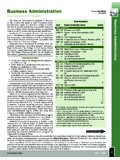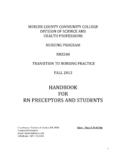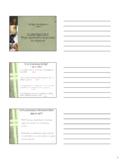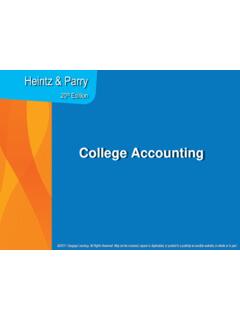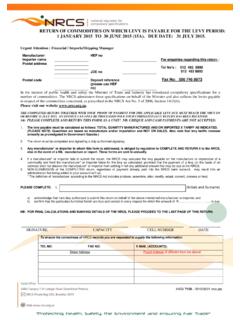Transcription of Accounting for Governmental Operating Activities ...
1 Copyright 2010 by The McGraw-Hill Companies, Inc. All rights reserved. McGraw-Hill/IrwinChapter4 Accounting for Governmental Operating Activities Illustrative Transactions and Financial Statements4-2 Learning ObjectivesAfter studying Chapter 4, you should be able to: Analyze typical Operating transactions for Governmental Activities and prepare appropriate journal entries at both the government-wide and fund levels Prepare adjusting entries at year-end and a pre-closing trial balance Prepare closing journal entries and year-end General Fund financial statements4-3 Learning Objectives (Cont d) Account for interfund and intra-and inter-activity transactions Account for transactions of a permanent fund Distinguish between exchange and nonexchange transactions, and define the classifications used for nonexchange transactions4-4 Measurement focus: Governmental funds focus on the flow of current financial resources Includes cash, receivables, marketable securities, prepaid items, and supplies inventories Capital assets are not recorded in Governmental funds, but are recorded in Governmental Activities at the government-wide level Basis of Accounting :Modified accrualGovernmental Funds4-5 Dual-track approach Transactions have different effects on Governmental funds and Governmental Activities at the government-wide level because of different measurement focuses and bases of Accounting Using the dual-track approach each transaction is recorded separately in the general journals for the Governmental fund and Governmental activitiesGovernmental Funds (Cont d)4-6 The budget for Clark City authorizes expenditures of $11,360,000 and forecasts revenues of $10,972,000 for FY 2011.
2 The entry to record the budget (ignoring subsidiary detail) is:General Fund: Revenues10,972,000 Budgetary Fund Balance388,000 Appropriations11,360,000 Recording the Budget at the Beginning of the Year4-7 Question: Referring to the budget just recorded in which appropriations exceed estimated revenues by $388,000, is this an example of poor financial management? (See next slide)Recording the Budget at the Beginning of the Year (Cont d)4-8 Answer:A budgetary deficit does not necessarily indicate poor financial management To provide a financial cushion to cover revenue shortfalls or unexpected expenditure needs, governments usually maintain a target ratio of Unreserved Fund Balance to General Fund Revenues in the range of 10 to 20 percent If the reserve is larger than the target level, the City Council (or other legislative body) may intentionally budget a deficit to reduce fund balanceQ: Is This an Example of Poor Financial Management?
3 4-9 Before a department can order materials and supplies or equipment, the department should verify that a sufficient unexpended appropriation exists to cover the items being orderedThis process is sometimes referred to as preauditing Encumbrance Accounting 4-10 Assume that the following departments of Clark City place purchase orders for supplies totaling $420,000, the entry would be:General 2011420,000 Reserve for Encumbrances 2011420,000 Encumbrances Subsidiary Ledger:General Government 80,000 Public Safety 210,000 Public Works130,000 Encumbrance Accounting (Cont d)4-11 Clark City recorded expenditures of $432,000 for goods received that had been ordered in the preceding transactionGeneral for Encumbrances 2011420,000 Expenditures 2011432,000 Encumbrances 2011420,000 Vouchers Payable432,000 See next slide for subsidiary ledger entries Accounting for Expenditures 4-12 Expenditures Ledger: Government78,000 Public Safety220,000 Public Works134,000 Encumbrances Ledger:General Government80,000 Public Safety210,000 Public Works 130,000 Accounting for Expenditures (Cont d)4-13 Governmental Activities .
4 General Government78,000 Expenses Public Safety220,000 Expense Public Works134,000 Vouchers Payable432,000 Note that the earlier budgetary entry for encumbrances has no effect at the government-wide levelAccounting for Governmental Activity Expenses 4-14 Payroll Accounting is similar for a Governmental fund and a for-profit entity, except Expendituresrather than Expenses are recorded Debit Expendituresfor full amount of payroll and credit liabilities for withholdings from employees pay; credit Cash for the amount paid to employees Record Expendituresfor the employer s payroll costs, including employer s share of FICA and credit a liability to federal government Encumbrances usually are not recorded for recurring expenditures such as payrollAccounting for Payroll4-15 Clark City recognized its payroll for the most recent two week pay period for employees paid from the General FundGeneral Fund: 2011948,000 Due to Federal Government86,000 Due to State Government49,000 Cash813,000 Expenditures Subsidiary Ledger:General Government178,000 Public Safety480,000 Public Works290,000 Accounting for Payroll (Cont d)4-16 The journal entry to record the payroll in the Governmental Activities journal at the government-wide level is: Governmental Activities .
5 General Government178,000 Expenses Public Safety480,000 Expenses Public Works290,000 Due to Federal Government86,000 Due to State Government49,000 Cash 813,000 Accounting for Payroll (Cont d)4-17 The employer s share of FICA is recorded inthe General FundGeneral 2011 88,000 Due to Federal Government 88,000 Expenditures Ledger:General Government16,523 Public Safety44,557 Public Works26,920 Accounting for Payroll (Cont d)4-18 The employer s share of FICA is recorded in thegovernmental Activities journal Governmental General Government16,523 Expenses Public Safety44,557 Expenses Public Works26,920 Due to Federal Government88,000 Accounting for Payroll (Cont d)4-19 The tax levyis the amount billed to taxpayers Initial determination of required tax levy: Levy = Revenues required Estimated collectible proportionAccounting for Property Tax Revenue4-20 The tax rateis the measure that is actually set by legislative action, after the required size of the levy is determined.
6 Tax rate (per $100 or per $1,000 of assessed valuation) = required tax levy assessed valuation (see next slide for definition of assessed valuation) If tax rate exceeds the statutory limit it will be necessary to reduce the required tax levy and readjust the budget accordinglyAccounting for Property Tax Revenue (Cont d)4-21 Accounting for Property Tax Revenue (Cont d) Assessed valuationis generally determined by an elected Tax Assessor Calculation: Assessed valuation = estimated true value of taxable property X assessment ratio In many jurisdictions the assessment ratio is ( , full estimated market value); in other jurisdictions it might be some fraction of full value4-22 Assume revenues of $495,000 are required and it is estimated that 1% will be uncollectible:Levy = $495,000/.99 = $500,000.(ignore subsidiary ledger entry) Current500, ,000 Revenues495,000 Accounting for Property Tax Revenue (Cont d)4-23 The required entry at the government-wide level is similar except for that the credit is to General Revenues as follows: Governmental Current500, ,000 GeneralRevenues PropertyTaxes495,000 Accounting for Property Tax Revenue (Cont d)4-24 Assume by the end of year $450,000 of current taxes have been collected, the entry is: ,000 TaxesReceivable Current450,000 Accounting for Property Tax Revenue (Cont d)4-25 The entry to reclassify uncollected current taxes to delinquent status at year-end.
7 Delinquent50,000 EstimatedUncollectibleCurrentTaxes5,000 TaxesReceivable Current50,000 EstimatedUncollectibleDelinquentTaxes5,0 00 Accounting for Property Tax Revenue (Cont d)4-26 Interest and penalties of $500 are accrued on delinquent taxes, of which 10% is estimated to be uncollectible. General and Penalties Receivable on Taxes500 Estimated Uncollectible Interest and Penalties50 Revenues450 Revenues Subsidiary Ledger:Interest and Penalties on Delinquent Taxes450 Accounting for Property Tax Revenue (Cont d)4-27 The required entry to accrue interest and penalties at the government-wide level is similar, except for the revenues account: Governmental and Penalties Receivable on Taxes500 Estimated Uncollectible Interest and Penalties50 General Revenues Interest and Penaltieson Delinquent Taxes450 Accounting for Property Tax Revenue (Cont d)4-28 Write-off of uncollectible taxes.
8 Assume property taxes of $500 are written off, on which accumulated interest and penalties amount to $80. The required journal entry is:General Fund and Governmental Uncollectible Delinquent Taxes500 Estimated Uncollectible Interest & Penalties 80 Taxes Receivable Delinquent500 Interest and Penalties Receivable on Taxes 80 Accounting for Property Tax Revenue (Cont d)4-29 Revenues from property taxes are often collected during one or two months of the year Expenditure demands may occur more or less uniformly during the year A local bank may extend a line of credit in the form of TANs to meet short-term cash needs since the notes will be backed by the power of lien over taxable propertiesIssuance of Tax Anticipation Notes (TANs) 4-30 Assume on April 1, 2011, Clark City signs a 60-day $300,000 tax anticipation note, discounted at 6 percent per annum. General Fund: 297,000 Expenditures 2011 3,000 Tax Anticipation Notes Payable 300,000 Note: X 60/360 X $300,000 = $3,000.
9 The entry at the government-wide level would be the same, except the debit is to Expense Interest on Tax Anticipation Notes instead of ExpendituresTax Anticipation Notes -TANs (Cont d) 4-31 Clark City repaid the 60-day $300,000 tax anticipation note on the due Fund and Governmental Anticipation Notes Payable 300,000 Cash300,000 Tax Anticipation Notes -TANs (Cont d) 4-32 Interim financial reporting is used for internal management purposes; it is not required for external financial reporting At a minimum, interim budgetary comparison schedules such as those shown in Illustrations 4-3 and 4-4 should be preparedInterim Financial Reporting4-33 Question:Why might a government need to revise its legally adopted budget during the year? of the Budget During the Year4-34 Answer: An error may have been made in estimating revenues or expenditures, or changed conditions may have altered estimated revenues or caused unforeseen expenditure needs.
10 Also, because the budget is legally binding on managers, it is important that the budget be revised to reflect changed conditions Q. Why Might a Government Need to Revise its Legally Adopted Budget During the Year?4-35 Answer: If estimated revenues is increased,debit Estimated Revenues and creditBudgetary Fund Balance. If appropriations areincreased, debit Budgetary Fund Balance andcredit Appropriations A decrease in either item would result in the reverse of the above entry Subsidiary ledger detail accounts would be adjusted accordinglyQ: How are Budget Revisions Recorded?4-36 Accounting for encumbrances depends on the budget laws of a particular state or other government In some jurisdictions, appropriations do not expire at year-end In other jurisdictions, appropriations lapse and encumbrances for goods on order at year-end require a new appropriation in the next fiscal year We examine the most common situation: Appropriations lapse, but the government will honor encumbrances for goods still on order at year-endEncumbrances of a Prior Year4-37 Assume at the end of FY 2010, a Reserve for Encumbrances was reported for $8,300.
